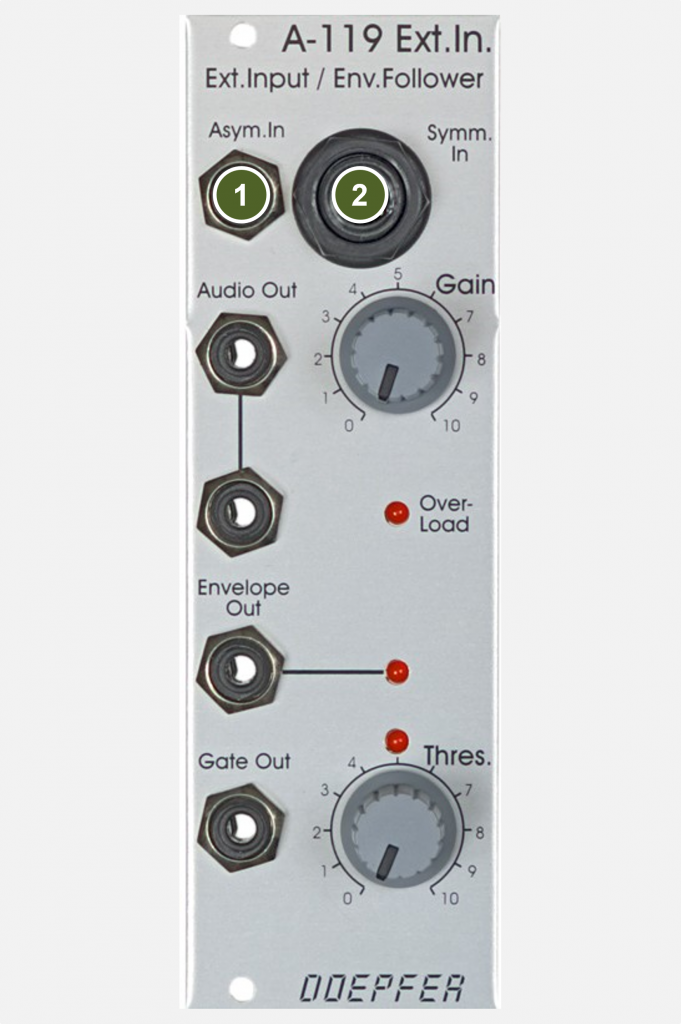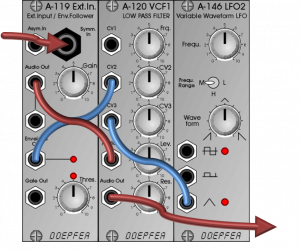The idea of running an audio signal such as vocals or drums through a modular system is always popular – with hopefully musically usable output.
In addition to the often heard filtered drums, you can of course do a lot of creative things this way. The A-119 module performs several tasks:
- Attenuate or amplify the input signal (e.g. for signals directly from guitar or microphone) with a clipping indicator for the level control.
- Generating a control voltage that follows the volume of the input signal (“envelope follower”) – the resulting envelope can then control other modules.
- Generating a trigger signal when a volume threshold is exceeded. The trigger can then be used, for example, to start an ADSR envelope of the synthesizer.
User interface
Inputs:

- Asymm. In: Asymmetrical input for line-level signals (e.g. from a mixer, other A-100 modules, etc.)
- Symm. In: Balanced input for signals with a lower level (guitar, bass, microphone), the gain factor here is significantly larger than with the asymmetrical input.
Outputs:

- Audio Out: The pre-amplified signal from the input of the module is present here. The preamplification is adjusted with the Gain control. To simplify some patches, the output is designed twice – as a mini-multiple, so to speak. An overload LED warns of overloading.
- Envelope Out: A so-called “envelope follower” creates an envelope from the volume of the input signal. The higher the amplitude, the greater the voltage that is present at this output. An LED shows the level of the current output voltage.
- Gate Out: When a volume threshold is exceeded, a gate signal is generated that can be used, for example, to trigger an ADSR generator. The threshold value can be adjusted with the “Thres.” control; an LED displays the gate signal.
Controls:

- The Gain control is used to adjust the pre-amplification for the input signal.
- The Thres. controller is used to set the volume threshold for triggering the gate signal. Set the threshold so that sounds are recognized and trigger the gate, but small background noises are still below this threshold.
Possible uses
Auto-Wah

Plug in your guitar or microphone. Audio Out through filters and VCA, the whole thing then controlled via the envelope from the envelope out – a nice auto-wah is ready. Of course, this also works with drums and is almost like a standard.
Edit transients with ADSR

With drums, things get a little more interesting when the gate created by the A-119 then drives an ADSR envelope for a VCA: This allows you to “soften” the drums (with a slight attack time in ADSR, the percussive character is severely affected) or make them even “sharper” (minimal attack time and short decay to a medium to low sustain level). This is basically what “Transient Shapers” do.
Ducking
Sometimes it is useful if another sound is blocked out when a noise/tone occurs. Sort of like with the radio: As soon as the speaker speaks, the music becomes significantly quieter. This is called “ducking” and is quite easy to do with the A-119. The signal from the “radio announcer” (to stick with our example) is the input signal from the A-119. Gain is adjusted appropriately so that a clear envelope is created. The envelope out signal is inverted (e.g. by an A-175) and then used as a control signal for a VCA. This VCA (e.g. A-131 or A-132-3) is the amplifier of the “music” and basically has a constant level that is set using the gain control. Depending on the choice of gain and attenuator in the VCA for the envelope signal, the “music” becomes significantly quieter as soon as the “speaker” says something.
To prevent the music from immediately becoming louder every time the speaker takes a breather, you can edit the control voltage after the inverter with an A-170 Slew Limiter (set greater “smoothing” for increasing voltage).
Technical specifications
| Width | 8 HP |
| Depth | 45 mm |
| Power requirements | 30 mA (+12V) / -20 mA (-12V) |
